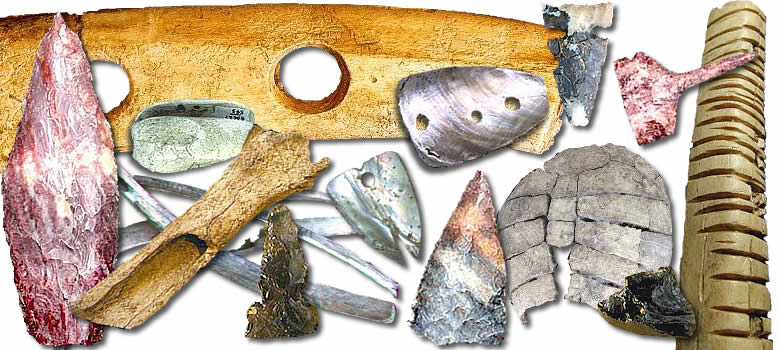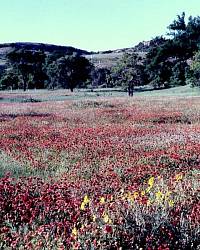
Spring time flowers along Wolf Creek following
a wet spring. Such conditions would have meant good years
for the corn planted by Plains Villagers. Photo by David Hughes.
Click image to enlarge
|
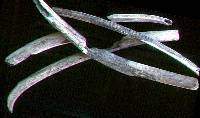
These bison ribs were found cached together
in the Courson B house. Several of them have a row of parallel
notches. These may be rasps used as musical instruments. Photo
by David Hughes.
|
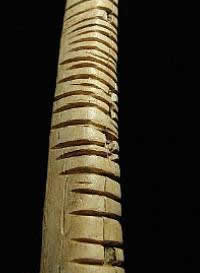
Closeup of an Antelope Creek rasp similar
to those found at Buried City (although this one is made on
a limb bone rather than a rib). Rasps were presumably used
as musical instruments by stroking the notched bone with a
hardwood stick. Notice the polish along the notched edge.
From the collections of the Panhandle Plains Historical Museum,
photo by Steve Black.
|
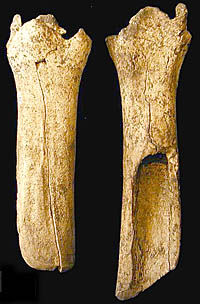
Bison tibia (lower leg bone) tools used
to tip digging sticks. From the Courson Buried City collection,
photo by Steve Black.
|
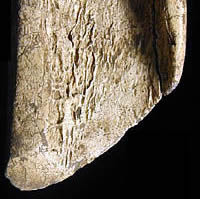
Closeup of characteristic wear patterns
present on bison tibia tools including edge rounding, smoothing,
and polish from contact with soil. From the Courson Buried
City collection, photo by Steve Black.
|
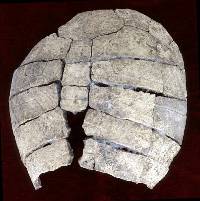
Tortoise shell. Shells like these were
used for rattles, bowls, and paint containers by various Plains
Indian groups. Photo by David Hughes.
|
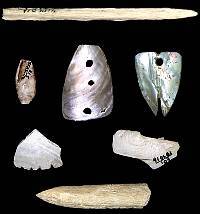
Shell and bone artifacts from Buried City.
The two bone fragments have been shaped to form sharp points
and may have been used to stretch holes in leather during
lacing. Native mussel (freshwater clam) shell was notched,
cut, and drilled to create pendants. Photo by David Hughes.
|
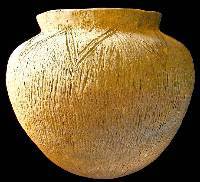
Replica of cordmarked jar with an incised
decoration by Alvin Lynn. From the Courson Buried City collection,
photo by Steve Black.
|
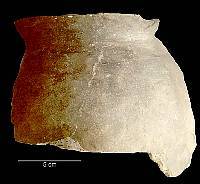
Buried City jar with smoothed exterior
surface. Photo by David Hughes,
|
| |
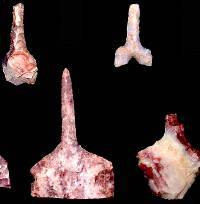
Stone drills with delicate bits made of
Alibates flint. Photo by David Hughes.
|
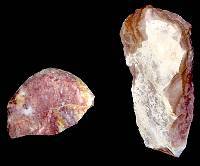
Hide scrapers made of Alibates flint. Photo
by David Hughes.
|

Obsidian arrow points and tool fragments
from Buried City. Such materials were traded from New Mexico
and other distant sources. From the Courson Buried City collection,
photo by Steve Black.
|
|
The people of the Buried City were gardeners, hunters,
and foragers. We know they raised corn and we strongly suspect
they also grew other crops like beans, squash, and chili peppers,
although these don't preserve well archeologically. Crops were
probably planted in the low-lying swales between houses and along
the valley floor (floodplain). During especially wet years when
floodwater occasionally inundated the valley floor, simple diversion
dams (lines of stones and/or rows of bushes) across the swales would
have kept the fields wet enough for good crops. This strategy is
similar to the Ak-Chin dryland farming technique used in
northwest Mexico and southern Arizona by various groups including
the Pima and Tohono O'odham people (who are collectively known as
the Ak-Chin, from the O'odham word meaning "place where the
wash loses itself in the sand or ground"). During dry years
when the swale crops might not have been successful, those planted
in the valley floors would have had sufficient moisture to grow.
The abundant bison bone on the Buried City sites shows
that buffalo hunting was important. Buffalo provided meat
and many other useful products including hides and bones for tools.
We also find deer bones and antlers as tools so they were hunting
white-tail deer in the local area. (Antelope and deer bones are
quite similar and it is likely that antelope were also killed.)
In addition to large mammals, the bones of smaller critters are common
in the sites including those of cottontail, jackrabbit, turtles,
and frogs, as well as sunfish bones, drum fish teeth and abundant
freshwater mussels.
The vegetation in the area was diverse and the people
used western red-heart cedar as main support posts for the houses,
plum and winged elm wood for the wall posts, and lashed them all together
with willow withes, grape vines, and twigs of plum and elm. The
hearths contained charred wood from oak, elm, juniper, plum, cottonwood,
and other species of trees. One visitor suggested that the oak-charcoal
layers in the firepits may represent winter-time use, while the
cottonwood charcoal and ash probably represent summer fires, the
difference being whether you want a long-term fire to keep the house
warm all night or a quick fire just to heat a meal.
The primary gardening tool was a digging stick
with a bone tip made from a bison tibia (lower leg bone—which
is thick and tough). Such tools had wooden handles inserted into
the end of the tibia (which had been cut or broken out) and may
have been used as hoes or as straight digging sticks/dibbles—sort
of like a narrow-bladed trenching shovel. Bison scapulae (shoulder
blades) may also have been used to move loose dirt and for smoothing
plastered surfaces. No stone hoes or other digging tools have been
identified at Buried City sites.
|
|
|
|
Artist's depiction of the
use of a bison tibia digging stick or "dibble." It
may have been used similarly as a shovel as well. Drawing by
Wade Parsons.
|
Artist's depiction of the
use of a bison tibia hoe. Drawing by Wade Parsons.
|
Bone was used for a variety of tools other
than for digging. We find bone awls and needles for making basketry
and clothing, deer jaws used as sickles for cutting grass, deer
antlers used for knapping flint, bison ribs that may have been used
as pot-stirrers, and abundant grooved or notched bison ribs that
may have been used as musical rasps, tally sticks, or for other
purposes. At one site, several notched ribs were found laying together,
as if for some particular social purpose beyond the mundane.
Marine shells like olivella and others from
the Gulf of California were used for ornaments like beads
and pendants. Native mussel shells (freshwater clam) were also
made into pendants by notching, cutting, and drilling holes into them. Some of the
native mussel shell may also have been used as pottery scraping
and smoothing tools and for spoons.
Although rare, turquoise ornaments are known
from Buried City. The source area for these lies to the west in
New Mexico. From the Courson Buried City collection, photo by Steve
Black.
Food was cooked and stored in locally made pottery
vessels. Buried City pottery was generally globular and about
8 to 12 inches in diameter, volleyball to basketball size, with
a constricted neck and a vertical rim. What sets Buried City pottery
apart from the similar-shaped pottery of the Antelope Creek area
(which is called Borger Cordmarked) is the abundant decoration of
the rims and the variety of surface finishes. About one-third of
the Buried City rim sherds include a variety of decorations like
fingernail impressions or gouging, impression of the rims with tools
like mussel shell, and thickening of the upper rim to form a collar.
We also see various incisions around the rim on the collar. In addition
to decorated rims, the pottery also includes cordmarked and smoothed
rims. Body sherds are most often cordmarked, but some seem to have been
textured with some other kind of tool, and still others have been
carefully smoothed. This kind of decoration on rim sherds and variation
in surface finish is more often found on Central Plains Tradition
sites (in Kansas and further north) than it is in Southern Plains
village sites.
Food was prepared in many ways including grinding,
and we find the remains of worn-out grinding slabs or metates in
all the sites as well as the hand stones or manos that were used
with them.
|
|
|
|
View from top of rim section
of large cordmarked olla, or jar, with a scalloped rim formed by
finger impressions. From the Courson Buried City collection,
photo by Steve Black.
|
Replica of Buried City jar
by Alvin Lynn. From the Courson Buried City collection, photo
by Steve Black.
|
Tools for hunting, processing meat and hides,
and for other purposes were made of Alibates flint and other cherts
and jaspers. Despite the nearness of Buried City to the Alibates
Flint Quarries, there is little evidence of substantial access to
Alibates flint on Buried City sites. Brown jasper from western Kansas
makes up a measurable percentage of the tools, as does Tecovas jasper
from the southern Texas Panhandle. Additional evidence of limited
contact with the Alibates quarries is that almost all of the tools
find have been extensively re-worked, worn-out, and recycled prior
to discard and even the flint-knapping debris is extremely small
and almost any flake that could be held between two fingers shows
edge damage from use as a scraping or cutting tool.
The styles of stone tools are fairly typical for the
Southern Plains people of the 12th and 13th century. These include
various kinds of drills or perforators, diamond-shaped beveled knives
sometimes called Harahey knives, and side-notched, unnotched, and
side- and base-notched arrow points. For arrows to fly true and
arrive with enough impact to take down a bison or with enough accuracy for a
deer, they must be carefully worked. We see some evidence of the
care in arrow manufacture in the form of a bison rib shaft straightener
or shaft wrench and a grooved abrader for smoothing the shafts once
they were straightened
As rich as the material we have may seem, most of
the goods owned by the people of the Buried City didn't survive the
ravages of time. We know from the needles, awls, and other tools
that they probably had clothing, bags, boxes, and other materials
made of hides, probably had baskets, mats, and sandals of woven
goods, and many objects and tools of wood and other perishable remains
which don't normally preserve.
|
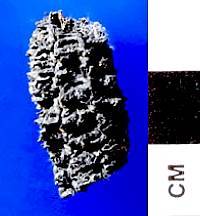
Fragment of a charred corn cob found at
Buried City. Photo by David Hughes.
|
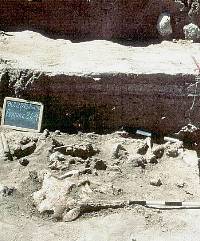
This pit filled with bison bone was found
under the Courson B house. The pit was an old pithouse depression
used for a trash dump prior to the building of the typical
Buried City house. All parts of a bison were found in this
pit, including the skull, indicating the animal(s) must have
been killed close by. Photo by David Hughes.
|
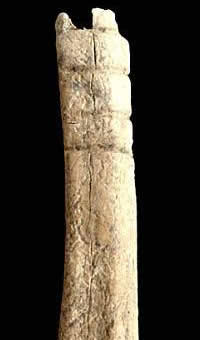
Bison rib fragment about 7 inches long
with regular notches. Function unknown. Photo by David Hughes.
|
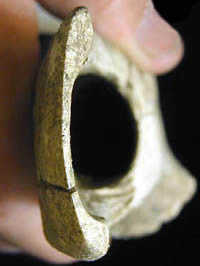
End-on view of the beveled tip of bison
tibia tool. From the Courson Buried City collection, photo
by Steve Black.
|
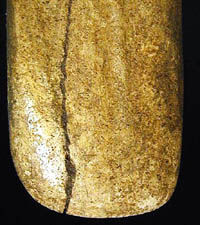
Closeup of bison tibia digging tool showing
polish. From the Courson Buried City collection, photo by
Steve Black.
|
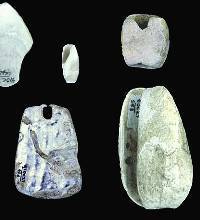
Marine shells (upper two on right and lower
right) like olivella and others from the Gulf of California
were used for ornaments like beads and pendants. Some of the
native mussel shell may also have been used as pottery-smoothing
and scraping tools and for spoons.
|
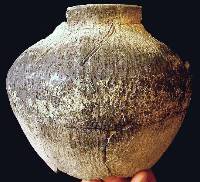
Large section of cordmarked jar with an
incised decoration. From the Courson Buried City collection,
photo by Steve Black.
|
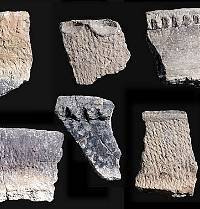
What sets Buried City pottery apart from
the similarly shaped pottery of the Antelope Creek area is
the abundant decoration of the rims and the variety of surface
finishes. Photo by David Hughes.
|

Rim section of large cordmarked olla or
jar with a scalloped rim formed by finger impressions. From
the Courson Buried City collection, photo by Steve Black.
|
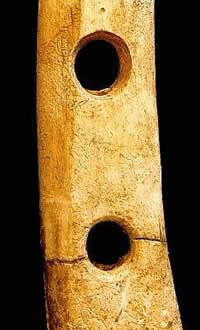
Bone arrow-shaft "wrench," used
to straighten arrow shafts. From the Courson Buried City collection,
photo by Steve Black.
|
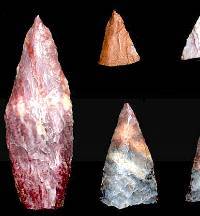
Knives and knife fragments made of Alibates
flint. Photo by David Hughes.
|
|
|
|
